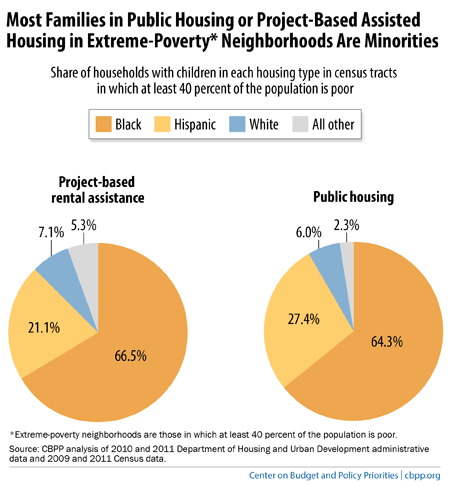BEYOND THE NUMBERS
Two Programs Could Boost Opportunity for Families With Project-Based Rental Assistance
More than 700,000 low-income families with children can afford decent housing by living in public housing or privately owned properties that the Department of Housing and Urban Development (HUD) subsidizes. As we explain in our recent paper, for about 200,000 of these families, having an affordable place to live entails living in an extremely poor neighborhood — where at least 40 percent of the residents have incomes below the poverty line, and crime rates tend to be higher and schools lower performing. Almost all of these families are racial or ethnic minorities (see chart).

HUD has begun two programs that could help more of these families live in higher-opportunity neighborhoods — if Congress provides sufficient funds and HUD and local partners implement the programs effectively: the Choice Neighborhoods Initiative (CNI) and the Rental Assistance Demonstration (RAD). Both programs aim to preserve and if necessary rebuild distressed rental units. CNI also has a broader goal to revitalize the neighborhoods of the assisted properties.
In the near term, two policy changes to these programs would increase the number of families that could live in safer neighborhoods with better schools. HUD should:
- Require housing authorities and other CNI grantees to offer relocating families effective mobility services. Many families forced to move during CNI-funded redevelopment likely will continue to live in private-market housing using the tenant-based vouchers provided to them as part of the relocation process rather than return to the redeveloped properties. Effective mobility services, including recruitment of landlords in low-poverty, high-opportunity communities; effective search assistance; and policies that allow vouchers to provide sufficient subsidies to make renting in higher-cost neighborhoods feasible for families, would better set up these families for success.
- Encourage local housing agencies to help residents of RAD properties access housing in high-opportunity areas. RAD requires housing agencies to allow most families in RAD developments to move with the first tenant-based Housing Choice Voucher that becomes available at their local housing agency after they have lived in the converted development for one to two years. With RAD residents in stable housing before they’re eligible to move with a voucher, they could benefit from counseling about neighborhood options and search techniques, which will help them make the best choice for their families when a voucher becomes available. HUD should provide guidance to agencies on best practices.
We’ll be back later today with a look at two other changes to RAD that could help low-income children over the longer term.
